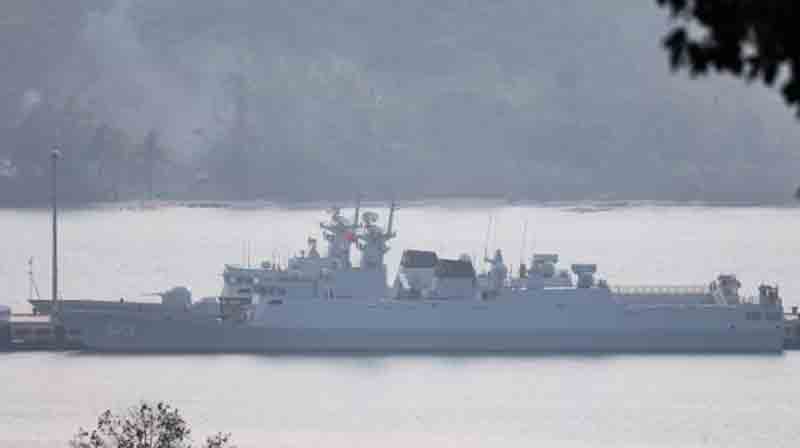In a significant geo-strategic development, India has stationed its advanced Russian-made S-400 Triumf long-range air defense system in the Siliguri Corridor, a narrow land bridge in West Bengal, often referred to as the “Chicken’s Neck” due to its vulnerable geography. This crucial stretch of land serves as the sole land link between mainland India and its resource-rich yet geographically isolated northeastern states, making it one of the nation’s most essential and exposed military routes.
The deployment of the S-400 system, known for its capability to engage multiple aerial targets simultaneously at distances over 400 kilometers, is perceived as a strategic response to the increasing aerial activities by China and Bangladesh near India’s eastern border.
New Delhi’s security officials have become increasingly concerned about the rising frequency and complexity of air operations by China and Bangladesh along their borders with the Siliguri Corridor, interpreting these actions as strategic probing. For many years, the corridor has been seen as a critical choke point in India’s national defense strategy, with military analysts cautioning that a well-coordinated attack, especially from China via the unstable Doklam Plateau, could quickly isolate the northeast from the rest of the country.
The alarming prospect of a divided India has prompted a shift in doctrine within India’s Eastern Command, which now emphasizes rapid response, multi-domain deterrence, and a sustained military presence in and around the corridor.
This adjustment in India’s military posture aligns with a noticeable diplomatic shift by Bangladesh’s interim government under Mohammad Yunus, which has been moving closer to Beijing in both its rhetoric and actions.
Following the downfall of the pro-India Sheikh Hasina administration, the interim government in Dhaka has actively sought investment and defense collaboration with China and Pakistan—two countries that New Delhi considers strategic rivals.
In an effort to realign its foreign policy, Bangladesh, under Yunus, has been pursuing economic and infrastructure partnerships with Beijing, raising concerns within India’s intelligence and security circles.
Particularly alarming for India are reports indicating potential joint infrastructure projects between Dhaka and Beijing, which New Delhi interprets through the lens of China’s Belt and Road Initiative (BRI), a program it has long criticized as a tool for geostrategic entrapment.
India has consistently opposed the BRI, cautioning that it allows the People’s Liberation Army (PLA) to establish dual-use infrastructure throughout the Indo-Pacific, thereby threatening regional sovereignty and military equilibrium.
As of April 2025, recent reports indicate that Bangladesh is considering the establishment of a Chinese-supported airbase in the northern Lalmonirhat district. This potential development has raised alarms in neighboring India due to the site’s proximity to the Siliguri Corridor.
In light of these escalating threats, India has not only activated its S-400 missile systems in the Siliguri area but has also bolstered its tactical air presence by deploying a squadron of Rafale multirole fighters to the nearby Hashimara Airbase. The Dassault Rafale, armed with Meteor beyond-visual-range missiles, SCALP cruise missiles, and sophisticated electronic warfare capabilities, stands as a powerful platform for air superiority and precision strikes, adept at countering both conventional and hybrid aerial threats.
These aircraft work alongside the legacy MiG fighters stationed at the base, creating a layered air superiority that enhances India’s capacity to quickly address any hostile incursions in the corridor.
Additionally, India’s integrated deterrence strategy is strengthened by the deployment of a BrahMos cruise missile regiment in the area, which offers rapid, supersonic precision strike capabilities against both ground and maritime targets within a range of 300 to 500 kilometers.
The Indo-Russian BrahMos missile, co-developed by DRDO and NPO Mashinostroyenia, is recognized as the fastest cruise missile currently in service and is pivotal to India’s “cold start” and preemptive strike strategies.
India has also established a comprehensive air defense system throughout the Siliguri Corridor, featuring the domestically developed Akash medium-range system, SHORAD (Short-Range Air Defence) batteries, and VSHORAD (Very Short Range Air Defence) systems to counter low-flying threats.
This integrated air defense network is engineered to detect, track, and intercept various aerial threats, from stealth drones to cruise missiles, ensuring continuous surveillance and readiness for combat at all times.
Central to India’s ground military presence in the region is the Trishakti Corps, based in Sukna, a unit known for its combined arms combat capabilities and operational excellence.
The corps is outfitted with T-90 Bhishma main battle tanks, elite mechanized infantry units, and a varied artillery inventory, regularly engaging in high-intensity live-fire drills that replicate cross-border confrontations and integrated battle group (IBG) maneuvers.
In addition to these conventional capabilities, India’s strategic response to Chinese military assertiveness is represented by the ‘Brahmastra Corps’—the nation’s inaugural dedicated mountain strike corps, officially known as XVII Corps and based in Panagarh, West Bengal.
This corps was established as a rapid deployment and counter-offensive unit, intended to execute deep strike operations across the challenging Himalayan landscape along the Line of Actual Control (LAC) with China. Comprising two infantry divisions, independent armored brigades, and specialized air defense and helicopter aviation units, the Brahmastra Corps is a vital component of India’s deterrence strategy in the eastern region.
In a significant incident last year, India reportedly issued a strong warning to Bangladesh after a Turkish-made Bayraktar TB2 drone, operated by the Bangladeshi military, approached dangerously close to the India-Bangladesh border. Citing senior Indian military officials, local media indicated that current standard operating procedures (SOP) prohibit any drone flights within a 10-kilometer radius of the international boundary to avoid surveillance of sensitive sites.
The official emphasized, “We possess the ability to monitor and neutralize any drone or aerial entity that intrudes into Indian airspace,” referring to ISR (Intelligence, Surveillance, and Reconnaissance) missions believed to have been carried out by Bangladeshi TB2 drones near Indian borders. This situation has led to increased vigilance in airspace following the detection of a Bangladeshi drone, identified by transponder ID TB2R1071, near critical areas in Meghalaya, Tripura, and Mizoram.
The drone was reportedly launched from Tejgaon Airbase in Dhaka and operated by the 67th Army of Bangladesh as part of a standard ISR operation, highlighting the changing surveillance landscape along the border. Bangladesh has acquired 12 Bayraktar TB2 medium-altitude, long-endurance (MALE) drones from Türkiye, with six units confirmed to be operational, significantly boosting Dhaka’s tactical ISR capabilities.
Of greater concern to India is Bangladesh’s alleged intention to procure up to 32 JF-17 Thunder fighter jets—an export-oriented, fourth-generation multirole aircraft developed collaboratively by Pakistan Aeronautical Complex (PAC) and China’s Chengdu Aircraft Industry Group (CAIG). New Delhi has voiced significant apprehension regarding this potential acquisition, perceiving it as a strategic partnership with its historical adversaries and a possible alteration in the regional air power equilibrium.
The JF-17, which is currently in service with the Pakistan Air Force, including the advanced Block III version, has been sold to multiple nations. It is equipped with AESA radar, electronic warfare systems, and capabilities for beyond-visual-range missiles, all supplied by China.
The already tense relationship between India and Bangladesh took another hit with reports of a high-level visit by officials from Pakistan’s Inter-Services Intelligence (ISI) to Dhaka.
This four-day visit, led by Major General Shahid Amir Asfar, sparked outrage in New Delhi, where officials view such interactions as a potential strategic alliance in India’s immediate vicinity.
In light of these events, India’s Ministry of External Affairs released a carefully crafted yet assertive statement, emphasizing that the government is “closely monitoring all developments in the region” and will respond appropriately to any threats to national security.
“We remain vigilant regarding all regional movements and actions that could impact national security. The Indian government will take decisive action as necessary,” stated ministry spokesperson Randhir Jaiswal.
India’s adjustment of its defense strategy in the Siliguri Corridor not only highlights its increasing concerns about shifts in regional power dynamics but also underscores its commitment to strengthening its eastern defenses against a possible two-front challenge from China and Pakistan, both of which are now forging closer ties with Dhaka.
Discover more from Defence Talks | Defense News Hub, Military Updates, Security Insights
Subscribe to get the latest posts sent to your email.





